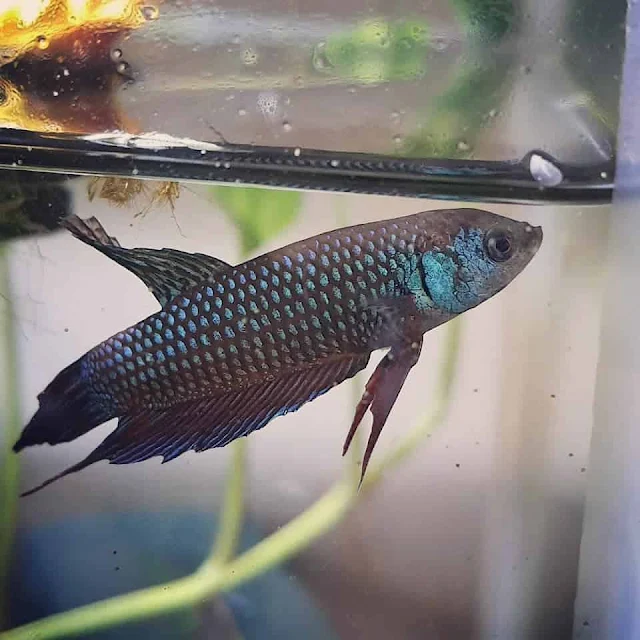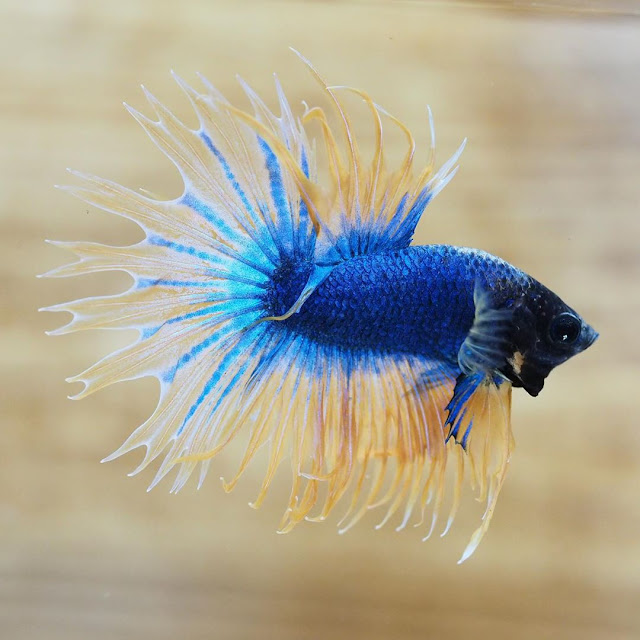A Fun Fact All About The Thailand Wild Betta Mahacaiensis Fish
A Fun Fact All About The Thailand Wild Betta Mahacaiensis Fish - The Betta Mahacaiensis, also known as Betta Mahacai, is a wild strain of betta fish native to Thailand. These wild betta species is one of the newest additions to the Betta Fish World.
These fighting fish species are a family of Oshpronemidae. They are found in some localities in Bangkok that is Samut Songkhram, Samut Sakhon, and Samut Prakan in Central Thailand, and all located on the coast of the Gulf of Thailand.
Other populations from different localities show a slight morphological distinction. For example, their form of the caudal fins can vary from rounded to ovate, and they shouldn't be mixed or hybridized with other species in the aquarium.
A Fun Fact All About The Thailand Wild Betta Mahacaiensis Fish
 |
| Copyright @aquaowner On Instagram |
Get Free Access To A Hundred Of Paid Betta Fish Guide Ebook On Amazon Kindle Store By Registering To Amazon Kindle Unlimited Membership
In nature, the Mahacaiensis Betta live in brackish, usually tidal, coastal swamps, and they are frequently associated with mangrove palm Nypa fruticans tree. This palm is generally known as the nipa palm tree. It's a unique palm tree that can especially be adapted to estuarine environments.
You May Like:
In their habitat, the males usually build their bubbles nests around the palm branches or between the bracts at the trees' base. It will provide protection and shelter to their eggs.
The water PH in their habitats precisely in Samkut Sakhon province varied around 6.87 to 7.80 with the salinity ranging from 1.1 till 10.6 ppt.
A Fun Fact All About The Thailand Wild Betta Mahacaiensis Fish
 |
| Copyright: frankbettas.com |
Buy The Betta Fish Tank On Amazon
The wild mahachai betta fish generally can reach a body length between 5 - 6 cm. Normally, an aquarium 45 x 30 or equivalent is enough to keep a pair of Betta Mahacaiensis fish.
They can live in an aquarium with medium-hard to hard fresh or in a tank with slightly brackish water conditions. These wild fighting fish will grow well in a planted tanks with plenty of surface covers such as floating plants or some tall stems.
Addition some dried leaf such as ketapang almond, beech or oak, it's very recommended. It will give the bettas more protection to fish from some diseases and establish microbe colonies as decomposition occurs. These microorganisms can be a secondary food source for fry fish. The tannin, another chemical released by the decaying leaves, is also given benefits to the bettas fish's health.
A Fun Fact All About The Thailand Wild Betta Mahacaiensis Fish
 |
| Copyright: ebay.co.uk |
Buy The Wild Betta Mahacaiensis On eBay
Because in nature, they live in sluggish waters, so the filtration should not be too strong. And don't forget to cover the tank as well. This wild betta is an excellent jumper.
Like another betta fish species, the male's Betta Mahacaiensis is more colorful can develop more extended fins than the female's bettas.
Such as the common betta varieties, the mahachai bettas can be fed by dried betta pellets, daphnia, artemia, or bloodworms. Its must you remember, do not overfeed the mahachai bettas seem particularly prone to obesity.
The spawning of betta Mahacaiensis is the same as other bettas species. The male will generally build the bubble nest in the safe areas under a board plant leaf or equivalent. During the spawning, the male will wrap the female many times.
A Fun Fact All About The Thailand Wild Betta Mahacaiensis Fish
 |
| Female Betta Mahacaiensis Copyright: betta.sollutions |
Buy The Best Fish Supplies On Amazon
At the point climax, milt and a few eggs are released. And then, both of them will collect the eggs and move them to the bubble nests. This process is then repeated until the female betta spent all of her eggs.
After that, the female betta is no longer active. The male betta will take over all responsibilities to guarding and tending their nest. Commonly the eggs will hatch between 24 - 48 hours. In 3-4 days after hatching, the fry still has yolk sac as their food while the male still guarding and collecting the fry, if any, that fall.
After a few days in which the fry can swim freely, the male will lose interest in them, and it's time to take it out into another aquarium. For the first few days, the fry will require infusoria-type food. After that, they will require large enough food such as microworm or artemia nauplii. Let's see other pictures of Betta Mahacaiensis:
A Fun Fact All About The Thailand Wild Betta Mahacaiensis Fish
 |
| Copyright @futterhaus_hamburg_stellingen On Instagram |
Buy The High-Quality Betta Fish Food On Chewy
 |
| Copyright @anemon.bettagallery On Instagram |
A Fun Fact All About The Thailand Wild Betta Mahacaiensis Fish
 |
| Copyright @calio4 On Instagram |
Read Also:
 |
| Copyright @calio4 On Instagram |
 |
| Copyright @falconfishroom On Instagram |
 |
| Copyright @falconfishroom On Instagram |
 |
| Copyright @blondatejsimpanz On Instagram |
 |
| Copyright @bettacadiz On Instagram |



Comments
Post a Comment